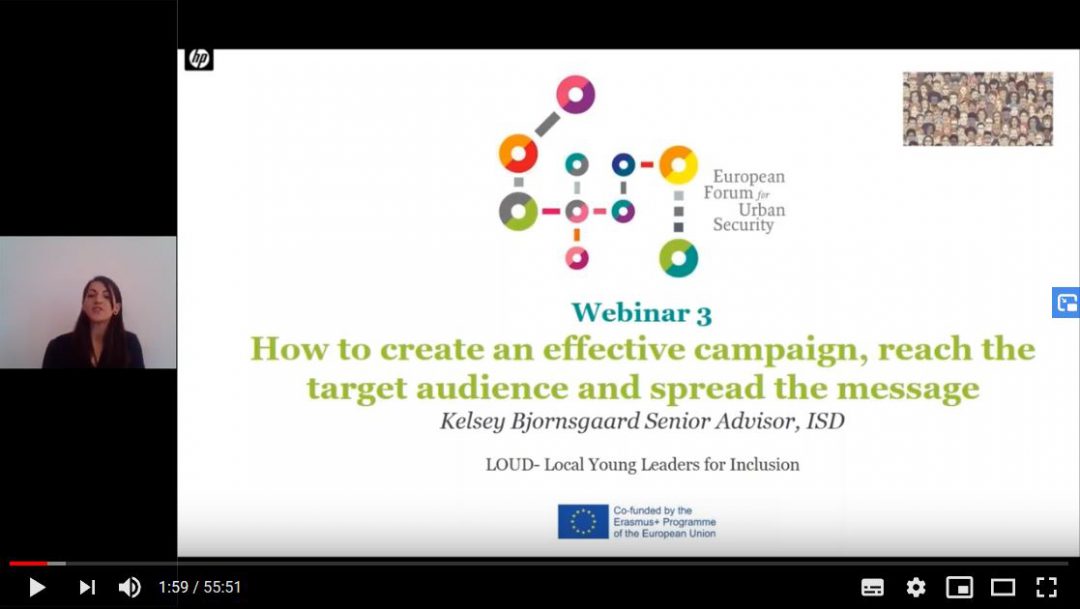July 2021 – The alternative narrative campaigns created by young citizens from nine European cities who were partners in the Efus-led LOUD project to promote inclusivity and tolerance against discriminations and extremism have had a positive impact on the target audiences, but also wider benefits for the participating youths and the partner cities. The main conclusion of the LOUD experts’ evaluation report, which was finalised in June, is indeed that they “have been quite successful, both online and offline” with “most stakeholders generally very satisfied with the campaigns and the lessons learned from the project.”
The experts* also noted that the fact that the campaigns were at all produced was in itself a success given that the Covid-19 pandemic prevented in-person meetings during much of the two-and-a-half-year project, which concluded in June.
The campaigns
Co-funded by the European Erasmus+ programme, LOUD aimed to foster inclusive environments for young people in order to prevent them from drifting into intolerance and extremist behaviours. To do so, the project sought to strengthen the capacities of local authorities to mobilise local young citizens for the prevention of discrimination and extremism through the creation of alternative narrative campaigns.
The nine partner cities – Leuven (BE), L’Hospitalet de Llobregat (ES), Augsburg, Düsseldorf (DE), Pella (GR), Rosny-sous-bois, Montreuil, Lille and Valenciennes Métropole (FR) – mobilised 114 local young citizens who designed and produced alternative narrative campaigns on inclusion, diversity and equality, which were disseminated through social media and posters in public spaces.
Objectives of the evaluation
The evaluation had three objectives. The first was to evaluate the impact of the local campaigns on the target groups, i.e., local young people, but also local society at large. Has the campaign contributed to self-reflection and critical thinking? Did they realize the damage they can do to others with hate speech? Are they strengthened in their competences to identify hate speech and to react?
The second objective was to evaluate the participation of the youngsters who designed and produced the campaign, with a mix of quantitative indicators such as the number of participants in any of the nine local groups, or the number of workshops and training sessions, and qualitative indicators such as “How did the campaign change your opinion?” or “How satisfied are you with your participation in this campaign”?
The third objective was to measure whether mobilising local young people to campaign for tolerance and against discriminations and extremism is an interesting, efficient tool for local authorities. Qualitative indicators were used here, with short interviews/surveys on questions such as “How satisfied are you with the process?” or “How does the action influence your prevention strategy?”.
Furthermore, some of the partner cities had their campaign peer-reviewed by the youngsters from other partner cities, for example youngsters from L’Hospitalet gave their feedback on the Leuven campaign, those from Leuven did the same for Pella, as did those from Valenciennes for Lille.
Main results
Since the project produced nine different campaigns, there are nine sets of evaluation results, which would be impossible to summarise here. We can however give a few examples.
The Leuven campaign was viewed 749 times on Facebook and 144 times on YouTube and was mentioned in the local press. The youngsters from L’Hospitalet said that “the stories are moving and transmit, express and encourage empathy.”
The L’Hospitalet campaign reached 2314 views on YouTube, Instagram and Twitter with a viewing time of 13.8 hours (during the observation period). The young people from Pella who watched the campaign for peer review said that “they didn’t know about micro-racism before” and that the campaign was “very communicative and conveyed the message it was supposed to.”
The Montreuil campaign reached over 4,000 people and was viewed over 1,000 times on Facebook, and reached 2,000 and was viewed 1,000 times on Instagram. This campaign was not peer reviewed by youngsters from other LOUD partner cities, but the City of Montreuil said it was very satisfied with the campaign itself and the whole process of mobilising local young citizens for such a project. The videos produced are “a real tool that the municipality intends to use in the future on different types of occasion, for example during workshops bringing together young people and practitioners.”
Lessons learnt
The experts have drawn a series of recommendations that can be useful for any local or regional authority wishing to embark on a similar project based on local young citizens’ participation, including:
- The young people who participate in such projects should receive clear recognition for this. This can be a certificate of participation, a voucher or other benefits.
- A participatory approach is better than a campaign that is imposed on young people. They should be involved in the planning, implementation and dissemination of the campaign from the beginning.
- Mayors and local politicians are decisive players and should therefore always be involved, informed and convinced of the necessity of the activities.
*Shani Benoualid, Advisor for Digital and Social Networks at the French Interministerial Delegation for the Fight Against Racism, Anti-Semitism and LGBT Hate (Délégation Interministérielle à la Lutte Contre le Racisme, l’Antisémitisme et la Haine anti-LGBT, DILCRAH), and Markus Pausch, Professor of Political Science, University of Applied Sciences of Salzburg (Austria)





